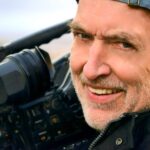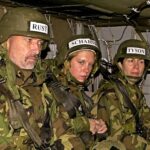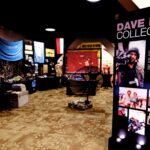In addition to international war coverage, natural disasters, terrorist attacks, and interviews with notable diplomats and world leaders for 35 years, PCC Distinguished Alum of 2010 David Rust has also garnered two Emmy Awards, been the subject of book interviews, and has had a CNN exhibit of his own personal collection and archive of memorabilia, artifacts and historical documents gathered during that time.

In addition to international war coverage, natural disasters, terrorist attacks, and interviews with notable diplomats and world leaders for 35 years, PCC Distinguished Alum of 2010 David Rust has also garnered two Emmy Awards, been the subject of book interviews, and has had a CNN exhibit of his own personal collection and archive of memorabilia, artifacts and historical documents gathered during that time.
A PCC alum and award-winning CNN cameraman, Rust has been a very busy man since the study his craft that began with The Courier and PCC in 1973.
He’s covered the Los Angeles Olympics, Iran’s defeat of the U.S. in the World Cup, the First Gulf War, the bombings of Baghdad, the truck bomb in Oklahoma City, the plane hijackings on 9/11, the southern squalls of hurricanes Katrina and Rita, and the eastern slam of hurricane Sandy.
Some of notable interviews where Rust was involved in covering as photographer for CNN include Fidel Castro, Pope John Paul II, Yasser Arafat, Ronald Reagan and Barack Obama.
While at Kent State in 1970, with an early interest in a military career while in their ROTC program, Rust became briefly involved with a major event that rocked the U.S. and changed his life.
Although not involved in the actual demonstrations and Vietnam War protests, he was curious. After leaving the campus one morning, four Kent State students were killed later on the campus by the National Guard stationed there to keep the peace. His return to the campus later revealed that the ROTC buildings had been burned down during the protests. The events resulted in a campus-wide shutdown and a drastic change in the national atmosphere.
“I watched how it broke in the news…how it became a national issue that affected a whole lot of people,” said Rust. “The whole business of television [became] interesting to me. I watched the way they worked and just thought it might be an interesting thing to do for a living.”
His father, also a PCC alum who attended concurrently with baseball Hall of Famer Jackie Robinson, thereafter brought the family back to California. It was then that Rust was introduced to Mikki Bolliger, the then-adviser to The Courier.
David’s wife, Agnes Rust, was a student from Hong Kong who joined the Courier prior to David. With her as editor-in-chief and him as managing editor, their very first paper together was an auspicious one. An entire column went unprinted—a void of space in the paper not since duplicated. In addition, Agnes and David’s pictures were switched by the printer in the layout in their respective articles— likely raising many a reader’s eyebrows.

On Rust as a writer, Agnes had a few choice words about her husband’s procrastination.
“He could never meet a deadline. He was chronic procrastinator and it persists to this day,” Agnes laughs. “During those times, you really had to go after him. He had a column. A conservative column at that time.”
“Politically he’s a lot more conservative than I am,” she continued. “We argue and I’m always right, so that’s okay,” she laughed.
But despite the delays, Rust still finished his stories and had the empathy of his adviser.
“You have to remember, considering what he’s doing now, he was just a kid fooling around,” said Mikki Bolliger. “They put out papers, they won awards, but he became serious about photography much more than writing while he was taking photography classes.”
According to Rust, the PCC campus has changed drastically since. The Shatford Library area was a Bob’s Big Boy restaurant and the Courier was in the C Building for a while. It was later relocated to PCC’s own wooden ROTC bungalows near the Aquatic Center. It was there that the Courier’s photography department was given its own darkroom.
“When I was in a four year school, and before I started at PCC, I just didn’t want to limit myself,” said Rust. “One of the things I learned about journalism is that you could ‘major’ in anything. There was no limit.”
Beginning in 1979–and all within a year’s time–Agnes and David married, had their first baby, and began a life navigating around Rust’s work with a then-fledgling 24-hour televised news network called CNN.
“News was not easy to get in at that time, especially network news. I figured if I got five years under my belt with CNN, I might be able to go to a real news network,” he laughs. “I just never left. It’s turned out to be a very good place to work.”
With CNN just reaching its 35th Anniversary as a network this year, Rust says that he and three of his colleagues have remained steadfast with the major network since its inception. He spent 13 years in the LA bureau prior to moving to the CNN headquarters in Georgia.
Furthering journalism in the family his oldest daughter Emily, a broadcast major at the University of Georgia, became part of the CNN. She is now Special Events Producer for events like the Sundance Film Festival, where she and Rust had the opportunity to work together, and presidential events. She even has occasionally been Rust’s supervisor.

Since then, Rust has won an Emmy for his coverage of Sarajevo stories in 1994. And along with his daughter Emily, CNN correspondent Wolf Blitzer, and their team, Rust earned another for their coverage of the 2012 presidential election.
And now he loves his work so much that he doesn’t even care or know how much he gets paid.
“I haven’t written a check in 30 years,” he laughs. “My wife takes care of everything. She does all the hard work.”
In 1991, Rust got a call at 4:30 a.m. to cover an event that would change forever how televised war is covered and further changing his life. The assignment was to Baghdad, which would put him in the thick of the widely televised spectacle of U.S. bombings that would keep him there for nearly 40 days covering the war in Iraq.
After scuttling through coalition bombers to a secret location in order to tape an interview of Saddam Hussein with Peter Arnett, for a live feed on CNN, they hurriedly erected an authorized satellite dish to broadcast the interview. It was at that moment that the air raids began. It was from the Al Rasheed hotel basement, using only flashlights, that their live feed became the single source of televised bombings that dominated the airwaves.
“I was also able to record images of cruise missiles en route to the city center of Baghdad and videotape rescue efforts at an air-raid shelter…after two smart bombs penetrated the ten-foot thick reinforced concrete roof,” Rust said in his online bio. “Local residents pulled me inside the shelter while it was still burning.”
More than 400 civilians died in the incident.
Rust covered another momentous event that included Baseball Hall of Famer Hank Aaron’s visit to Cuba for a dinner at the Presidential Palace with Fidel Castro, an avid baseball fan. Aaron brought a collection of baseball bats and balls garnered from the 1995 World Series game, where Castro signed several for Aaron.

Sheila Weller, author of the book “The News Sorority,” which is on the careers of journalists Diane Sawyer, Katie Couric, and Christiane Amanpour, features Rust largely in a section of dedicated to Bosnia and Amanpour, with whom he has worked with extensively.
Rust got further education on the value of his work and the responsibility as a journalist after nearly 10 months in Croatia and during his stint in Bosnia with Amanpour from 1992 – 1995.
“I knew nothing when I went over there, of the politics of it. Who was on what side, how many sides there were, who was doing what to whom? Who were U.S. allies prior to the war?” said Rust. “…But when you get over there and see everything and start to learn about it…you start to learn what all the sides are, how involved it is, and how crazy the situation was. Once you start to sort things out, you kind of feel like you have an obligation to be there to go ahead and cover that.”
In December of 1992, Rust was injured in an armored car that careened off an icy roadway. On the horrors of the war and some of the atrocities that have been historically reported, Rust was clearly affected by memories but his comments were limited.
“You’re working and that’s what you are thinking about when you are there, more than the horrific things that you are seeing,” he said.
Other than briefly participating in a research project regarding post-traumatic stress for journalists, the work doesn’t appear to come home with him.
In 2005, CNN put in a fresh water system into the Royal Sonesta hotel on Bourbon Street just so Rust and his team could remain to cover Katrina after that hurricane wiped out the whole lower Ninth Ward of New Orleans. During that time, the team trudged through high, polluted waters with reporter John King—not only cover the damage, but to follow the political delegations surveying the area.
Then Rita hit and moved northward and the team followed.

Included in the Rust Collection is a piece of sign debris that flew dangerous close during storm coverages, along with Cooper’s famously soaked red CNN slicker and a piece of broken levy that King held and referenced.
“The power of nature is so amazing. There are some things you can’t control whatsoever,” Rust said. “But you have to think about that. You have to put yourself into a position to escape from whatever you are doing.”
The morning of 9/11, news of the planes hitting the World Trade Center’s twin towers came to him while he was getting blood tests in order to travel on another assignment. Rust got the call.
And while covering the First Responders at ground zero, the Coast Guard offered to take them via helicopter during their survey of the area. The flight provided the unique aerial coverage of the area through four rotation passings. As all air flights were forbidden immediately thereafter, he and his team’s footage ended up being the only aerial footage taken and pooled for the other networks’ use.
With evolving technologies, drone use, and ethical issues in journalism, things are changing drastically in journalism, according to Rust, who offered some advice to students considering a future in journalism.
“They want everybody to do everything right now,” he said “The more you can learn about the technologies, the more secure you are going to be in getting a job.”
- Legacy of Courier adviser lives on - April 27, 2016
- Campus Police win first place in run from Baker to Vegas - April 22, 2016
- Condom van rolls onto campus to combat HIV - April 27, 2016



